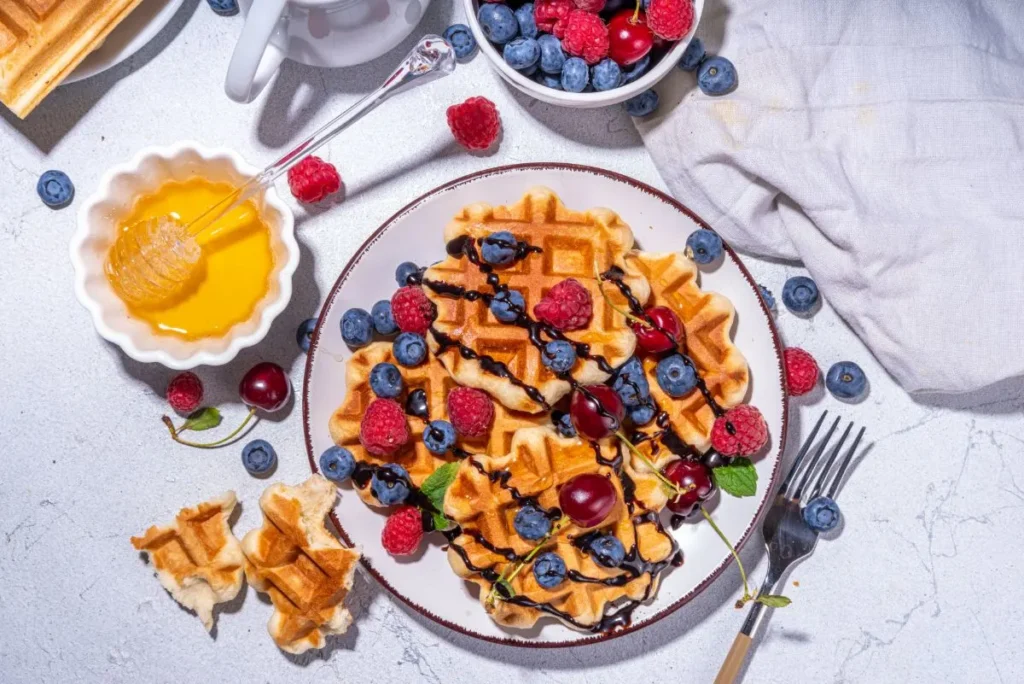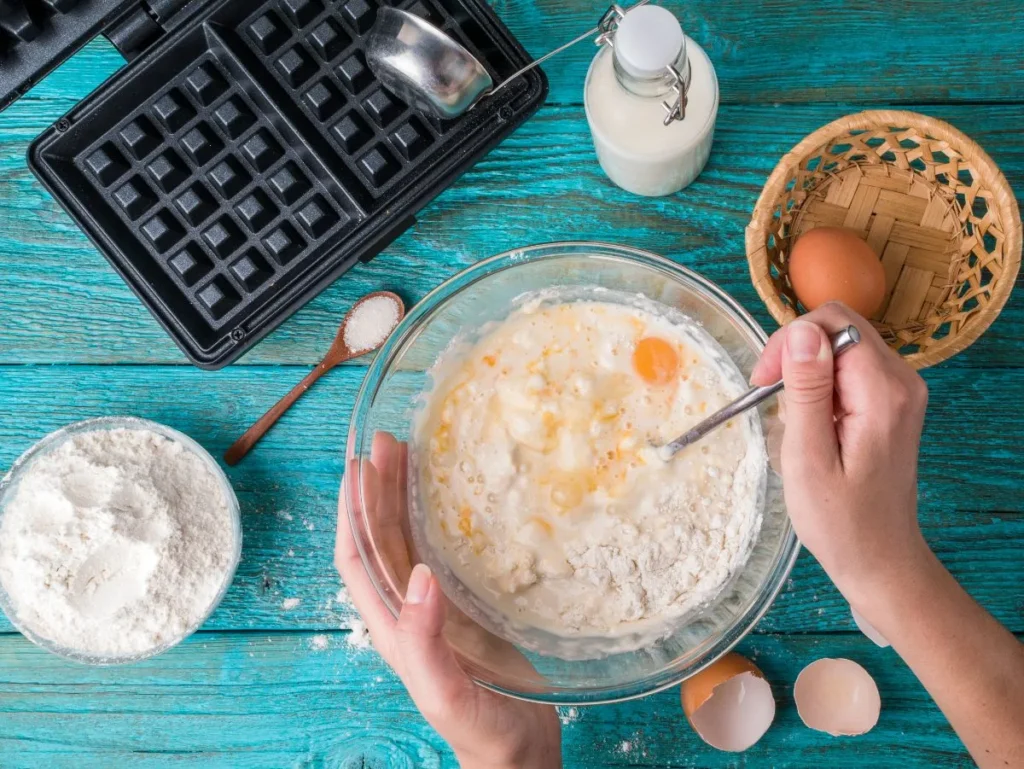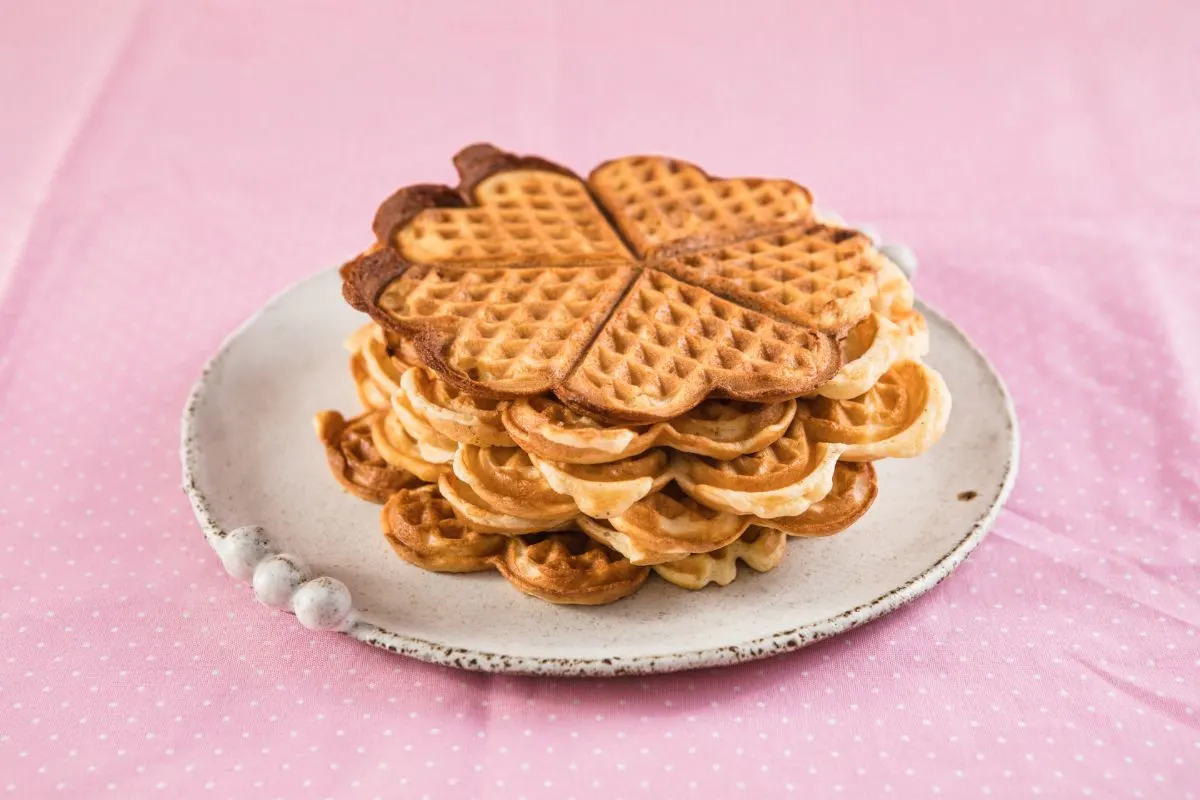Discover everything about waffle cookies, from their origins to mastering recipes, flavors, and techniques at home.
Introduction
Waffle cookies are a unique treat that blend the crispness of a cookie with the distinctive grid pattern and delicate tenderness of a waffle. In fact, they often fly under the radar, yet these sweet delights are becoming increasingly popular in the U.S. for their satisfying crunch, buttery richness, and subtle sweetness. Moreover, they offer a versatile base for countless toppings and decorations, making them perfect for a wide range of occasions, from a cozy weekend breakfast to a sweet afternoon snack.
As a result, in this in-depth guide, we will thoroughly explore the origins of waffle cookies, highlight various regional inspirations, and reveal the secrets behind achieving the ideal texture and taste. Additionally, we will cover essential tools, step-by-step methods, and expert tips to ensure your waffle cookies turn out crisp on the outside and tender on the inside. Furthermore, we will discuss modern variations, serving suggestions, and healthful adaptations. By the end, you will be fully equipped to master the art of waffle cookies in your own kitchen.
- Introduction
- Waffle Cookies: A Brief History
- Exploring Styles and Flavors
- Key Ingredients and Equipment
- How to Make Classic Waffle Cookies
- Nutritional Information
- Tips, Tricks, and Troubleshooting
- Serving Suggestions and Pairings
- Healthful Alternatives and Dietary Adaptations
- Frequently Asked Questions (FAQ)
- Conclusion
Waffle Cookies: A Brief History
The Origins of Waffle Cookies
Historically, waffle cookies have a rich background that traces back to European waffle-making traditions. Initially, centuries ago, European cooks pressed thin batters between hot metal plates, resulting in sweet, crisp wafers that inspired future innovations. Over time, people began experimenting with slightly thicker batters and different flavorings, eventually leading to treats that resemble what we now know as waffle cookies.
Moreover, waffle-making first emerged as a method to produce bread-like items for religious events, ceremonies, or holidays. Eventually, as waffle irons spread through households in countries like Belgium, the Netherlands, and France, new recipes and techniques evolved. Consequently, some of these variations were thinner, sweeter, and more delicate, shifting closer to the texture of a cookie than a breakfast waffle. After immigration brought these culinary traditions to the United States, they blended seamlessly into local baking customs, setting the stage for modern American waffle cookies.
Cultural Influences and American Popularity
In particular, Belgian and Dutch traditions provided crisp waffle wafers and stroopwafels that influenced the development of caramel-filled or spice-infused waffle cookies. Similarly, Scandinavian techniques introduced intricately patterned, thin waffle cookies like krumkake and goro cookies. As these European influences migrated across the Atlantic, American bakers adapted them for local tastes.
As a result, in the U.S., waffle cookies gradually found a place on bakery shelves, coffee shop menus, and family recipe boxes. Furthermore, as home cooks now embrace unique, artisan-style treats, waffle cookies have earned a loyal following. Today, they stand proudly alongside other beloved desserts, offering a satisfying crunch and comforting, home-baked flavor.
Exploring Styles and Flavors

Traditional Belgian-Inspired Waffle Cookies
Notably, Belgian-style waffle cookies draw inspiration from the famous Belgian waffle, featuring a delicate, buttery batter that results in a crisp shell and a slightly fluffy interior. In addition, these cookies often have a simple flavor profile—usually vanilla or almond—allowing the buttery richness to shine through. For instance, while Belgian waffle cookies are typically enjoyed plain, they can be easily elevated with powdered sugar, chocolate drizzle, or fruit preserves.
Scandinavian Krumkake and Goro Cookies
In contrast, Scandinavian countries boast thin and often intricately patterned waffle cookies that hold a special place at holiday celebrations. Specifically, krumkake (Norwegian waffle cookies) are delicate, lightly sweetened treats rolled into cone shapes, while goro cookies feature subtle flavors like cardamom. Although they may seem fancy, these cookies are surprisingly easy to prepare once you have the proper waffle iron and technique.
Stroopwafel Influences
Meanwhile, stroopwafels, a popular Dutch treat, inspire a type of waffle cookie that sandwiches a sweet syrupy filling between two thin waffle rounds. Moreover, although traditional stroopwafels use a caramel-like filling, modern variations experiment with chocolate or fruit-infused syrups. Consequently, by adapting the concept of filled waffle cookies, home bakers can create endless flavor possibilities.
Modern Gourmet Varieties
Likewise, as waffle cookies gain popularity, gourmet variations have emerged. For example, some bakers incorporate cocoa powder to create chocolate waffle cookies, while others add spices like cinnamon or nutmeg for depth. Additionally, you can experiment with lemon or orange zest, drizzle them with citrus glaze, or add nuts and seeds for crunch.
If you enjoy exploring unique breakfast or brunch treats, then you might also appreciate other creative recipes. For example, try our Sweet Potato Cornbread for a hearty side dish, or explore The Ultimate Guide to Mini Donuts to expand your collection of sweet morning indulgences.
Key Ingredients and Equipment
Flour and Sweeteners
Importantly, when making waffle cookies, choosing the right flour matters. For instance, all-purpose flour is versatile and reliable, yielding a sturdy yet tender texture. Conversely, if you seek a more delicate crumb, consider a combination of all-purpose and pastry flour. In addition, if you prefer a slightly hearty note, whole-grain flours add complexity and nutrition.
Furthermore, sugar type affects both sweetness and texture. While granulated white sugar ensures crispness, brown sugar adds a subtle caramel note, and powdered sugar creates a lighter texture. Therefore, experimenting with sugar blends can help you achieve the perfect balance.
Fats and Dairy
Similarly, high-quality butter is crucial for achieving a rich, decadent flavor in waffle cookies. As a result, it contributes both moisture and a distinctive taste. However, if you follow a dairy-free diet, you can substitute with plant-based butter or coconut oil. In addition, milk or cream add tenderness, while buttermilk infuses a subtle tang, making the final cookie more complex and interesting.
Flavorings and Add-Ins
Moreover, vanilla extract is a go-to flavor enhancer that complements the buttery base of waffle cookies. In fact, consider adding a pinch of warm spices like cinnamon or nutmeg for a comforting aroma. Additionally, grated citrus zest brings brightness, while almond or hazelnut extracts provide nutty depth. For more variety, you can also fold in finely chopped nuts, dried fruit, or mini chocolate chips for added texture and interest.
Essential Tools
Of course, a waffle iron (standard or specialty) is the primary tool you need. Since adjustable heat settings help you control browning, look for a model that allows temperature variation. Additionally, nonstick surfaces simplify the cooking process. As a final note, a silicone spatula, measuring cups, and a whisk make it easier to mix the batter thoroughly, while a cooling rack ensures that cookies remain crisp as they set. Consider investing in a pizzelle iron or a krumkake iron if you want to explore more delicate waffle cookies.
How to Make Classic Waffle Cookies

Below is a classic recipe for plain waffle cookies that you can easily customize. Therefore, this recipe yields crisp, slightly buttery treats that are perfect for enjoying on their own or decorating with various toppings.
Ingredients (Makes About 20 Cookies)
- 2 cups all-purpose flour
- 1 teaspoon baking powder
- ½ teaspoon salt
- ¾ cup unsalted butter, softened
- ¾ cup granulated sugar
- 2 large eggs, at room temperature
- 1 teaspoon pure vanilla extract
- ½ cup whole milk (or a dairy-free milk alternative)
Step-by-Step Instructions
Step 1: Prepare the Dry Ingredients
First, in a medium bowl, whisk together the flour, baking powder, and salt. Thus, blending these dry ingredients evenly ensures a consistent texture in your final batter.
Step 2: Cream the Butter and Sugar
Next, in a large mixing bowl, cream the softened butter and sugar until the mixture is light and fluffy. Indeed, this process usually takes about 2-3 minutes with an electric mixer. Consequently, creaming incorporates air, which helps create a delicate final texture.
Step 3: Add the Eggs and Flavoring
After that, add the eggs one at a time, beating well after each addition. In addition, this step prevents curdling and ensures a smooth batter. Then, stir in the vanilla extract. At this stage, the batter should be silky and well-blended.
Step 4: Incorporate the Dry Ingredients and Milk
Subsequently, with the mixer on low, add half of the flour mixture to the butter-sugar-egg mixture, then pour in the milk, followed by the remaining flour mixture. As a result, mix until just combined. Moreover, avoid overmixing, as it can lead to tough cookies. Ultimately, the final batter should be thick but spoonable.
Step 5: Preheat and Grease the Waffle Iron
Before cooking, preheat your waffle iron according to the manufacturer’s instructions. Additionally, lightly coat it with a neutral oil or nonstick spray. Notably, ensuring the iron is fully heated before proceeding helps achieve even browning.
Step 6: Cook the Waffle Cookies
Now, spoon about 1-2 tablespoons of batter into the center of the waffle iron. Thereafter, close the lid and cook for 2-4 minutes, depending on your waffle iron’s settings and desired crispness. In fact, check frequently to prevent overbrowning. Ideally, the cookies should turn a golden brown hue.
Step 7: Cool and Store
Finally, carefully remove the waffle cookies using a spatula and transfer them to a cooling rack. Consequently, this prevents them from getting soggy. Once they have cooled completely, store them in an airtight container. In order to preserve crispness, separate layers with parchment paper.
Nutritional Information
Below is approximate nutritional information per 100g serving of waffle cookies. Of course, please note that these values are estimates and may vary based on specific ingredients and modifications.
| Nutrient | Amount per 100g |
|---|---|
| Calories | 420 kcal |
| Total Fat | 20 g |
| Saturated Fat | 12 g |
| Carbohydrates | 54 g |
| Sugar | 25 g |
| Protein | 5 g |
| Fiber | 1 g |
| Sodium | 250 mg |
Tips, Tricks, and Troubleshooting
Preventing Sticking and Uneven Cooking
Occasionally, waffle cookies may stick. Therefore, to avoid this, ensure that your waffle iron is hot and lightly greased. If the cookies cook unevenly, try adding a bit more batter or adjusting your waffle iron’s heat setting. In addition, rotating the iron or carefully repositioning the batter can help achieve a uniform color.
Adjusting Sweetness and Texture
If your cookies taste too sweet, consider reducing the sugar slightly. Conversely, if you prefer a softer texture, add a bit more milk or butter. On the other hand, if you enjoy a crunchier cookie, simply cook them a bit longer or cut back on dairy.
Common Mistakes and Quick Fixes
- Batter too thin: As needed, add a spoonful of flour to thicken it.
- Batter too thick: In contrast, add a splash of milk to loosen it.
- Cookies pale or undercooked: Therefore, increase the cooking time or heat setting.
- Cookies burned on edges: Meanwhile, lower the heat or reduce cooking time to prevent char.
Serving Suggestions and Pairings
Toppings and Garnishes
Certainly, waffle cookies are delightful served plain, but they pair exceptionally well with various toppings. For example, drizzle them with melted chocolate, add a dollop of whipped cream, or sprinkle them with powdered sugar. Moreover, fresh berries, caramel sauce, or a thin layer of nut butter can elevate your waffle cookies to a more decadent dessert.
Beverage Pairings
Additionally, waffle cookies are versatile enough to accompany breakfast, snack time, or dessert. For instance, enjoy them with hot coffee, a fragrant herbal tea, or a creamy hot chocolate. Ultimately, their light sweetness and crisp texture complement many beverages without overwhelming them.
Healthful Alternatives and Dietary Adaptations
Gluten-Free and Dairy-Free Options
If you require a gluten-free option, you can replace the all-purpose flour with a certified gluten-free baking blend. Moreover, for dairy-free adaptations, choose plant-based butter and a non-dairy milk like almond or oat. Consequently, the result may be slightly different in flavor and texture, but still delicious.
Reducing Sugar and Using Whole Grains
If you want a more nutritious version, try cutting back on sugar by about 25%. Additionally, if you seek more fiber, replace up to half of the all-purpose flour with whole wheat or spelt flour. As a result, these changes will produce a more complex flavor profile and a slightly heartier cookie.
If you enjoy healthful adaptations, you may also like our wholesome, protein-rich breakfast ideas. For example, check out our Protein Pumpkin Muffins Guide which is perfect if you are looking to start your day with something both nutritious and sweet.
Frequently Asked Questions (FAQ)
What is Snoop Dogg cookies?
Interestingly, Snoop Dogg cookies generally refer to a well-known line of cookies or cookie recipes associated with the iconic musician Snoop Dogg. In fact, he has published cookbooks featuring comfort foods, including various dessert recipes. Although these are not specifically waffle cookies, his creative flair could inspire your own spins on classic treats.
What is the waffle cookie called?
Generally, waffle cookies can have different names depending on their origin. For instance, in Norway, they are known as krumkake. Belgian waffle cookies are often simply referred to as “waffle cookies” or “Belgian waffle cookies.” Meanwhile, stroopwafels are a Dutch variation that sandwiches syrup between two waffle-like wafers.
What are waffle cookies made of?
Typically, waffle cookies are made from a simple batter of flour, sugar, butter, eggs, and milk, often flavored with vanilla or other extracts. Moreover, some variations include spices, citrus zest, or fillings. Significantly, the batter is cooked in a waffle iron, creating their signature grid pattern and crisp exterior.
Can you put cookie dough in a waffle maker?
Yes, you can use certain cookie doughs in a waffle maker. However, you may need to adjust the dough’s consistency. For example, thinner batters cook more evenly. Some doughs, especially those with high butter content, can spread unevenly, so it’s best to start with a basic waffle cookie recipe before experimenting.
Additional FAQs
How do I store waffle cookies?
Ideally, keep waffle cookies in an airtight container at room temperature. Therefore, separate layers with parchment paper to maintain crispness. They stay fresh for about a week.
Can I freeze waffle cookies?
Certainly, place them in a freezer-safe container or bag, and they will remain fresh for up to 2-3 months. After freezing, thaw at room temperature and warm briefly in a low oven if desired.
Conclusion
In conclusion, waffle cookies bring together the best aspects of waffles and cookies. Therefore, they are crisp, sweet, buttery, and endlessly versatile. Throughout this guide, we’ve explored the origins of waffle cookies and uncovered the secrets of mastering this delightful treat at home. Moreover, from selecting quality ingredients to troubleshooting common issues, you now have the know-how to create waffle cookies that suit your personal taste and dietary needs.
As you continue experimenting, consider using creative fillings, alternative flours, and bold flavor combinations. Ultimately, waffle cookies can be enjoyed at breakfast, as a snack, or as a dessert. Above all, have fun and embrace the versatility that waffle cookies offer.

